Alternating Hammer Low Row Machine: The Ultimate Upper Body Exercise for Athletic Performance
When it comes to building functional upper body strength that translates directly to athletic performance, few exercises match the effectiveness of the alternating hammer low row machine. This dynamic variation of the traditional seated row transforms a standard strength exercise into a movement pattern that closely mimics real-world athletic demands while delivering exceptional results for back development and core stability.
Watch the video below on how to maximize this exercise.
What Makes the Alternating Hammer Low Row Machine Special?
The alternating hammer low row machine utilizes the renowned Hammer Strength low row equipment, which stands out in the fitness industry for its unique unilateral capabilities. Unlike traditional cable machines or standard rowing equipment, this machine allows you to work each arm independently, creating opportunities for more functional movement patterns that directly benefit athletic performance.
The key advantage of this alternating approach lies in its ability to keep the ribcage mobile throughout the exercise. For athletes and fitness enthusiasts who need to maintain rotational power and core stability, this continuous movement of the ribs during the rowing motion provides training benefits that extend far beyond simple back strengthening.
Understanding the Movement Pattern
The alternating hammer low row machine exercise begins with proper positioning and setup. You’ll start by maintaining an upright chest position while gripping the handles of the Hammer Strength machine. The beauty of this exercise lies in its alternating nature, where you row one arm back while the other remains in various positions depending on your specific training goals.
The basic alternating pattern involves rowing one arm back while keeping your chest elevated and core engaged, then switching to the opposite arm in a continuous, flowing motion. This creates a dynamic movement that challenges your stabilizing muscles while working the primary movers of your back, including the latissimus dorsi, rhomboids, middle trapezius, and posterior deltoids.
Advanced Variations for Enhanced Training Benefits
The alternating hammer low row machine offers several progression options that can dramatically increase the exercise’s effectiveness. One particularly challenging variation involves starting with both arms in the contracted position, then alternating the rowing motion while always keeping one arm in the pulled-back position. This creates an isometric challenge for the upper back muscles, forcing them to maintain strength under constant tension while the opposite arm performs the dynamic rowing movement.
For athletes seeking sport-specific benefits, a pumping-based variation mimics running mechanics by alternating the arms in a pattern similar to sprinting arm swing. While this variation requires careful attention to form and may not be suitable for all training programs, it can provide unique benefits for runners and athletes whose sports require coordinated upper and lower body movement patterns.
Programming the Alternating Hammer Low Row Machine
Effective programming of the alternating hammer low row machine typically involves two to four sets of six to ten repetitions per side. This rep range allows for adequate strength development while maintaining the movement quality necessary to gain the full athletic benefits of the exercise. The alternating nature of the movement means that each arm receives adequate work while the opposite side provides stability and core engagement.
The exercise works particularly well within athletic training programs where unilateral strength, core stability, and movement coordination are priorities. Unlike bilateral rowing exercises that can sometimes allow compensation patterns, the alternating format demands that each side of the body contribute equally to the movement, helping to identify and address strength imbalances.
Benefits for Athletic Performance
The alternating hammer low row machine delivers several performance benefits that extend beyond traditional back training. The continuous movement of the ribcage during the alternating pattern helps maintain and improve thoracic spine mobility, which is crucial for athletes in rotation-based sports like golf, tennis, and baseball.
Additionally, the unilateral nature of the exercise challenges the core stabilizers in a way that bilateral movements cannot match. As one arm pulls while the other maintains position, the deep core muscles must work to prevent unwanted rotation and maintain proper spinal alignment. This translates directly to improved performance in activities requiring anti-rotation strength and stability.
Equipment Considerations and Alternatives
The Hammer Strength low row machine is widely available in most commercial training facilities and has earned its popularity through consistent results and user satisfaction. The machine’s design allows for smooth, controlled movement while providing the stability necessary for heavy loading.
For those without access to the specific Hammer Strength equipment, similar benefits can be achieved using cable systems with D-handles, though the movement quality and stability may differ slightly from the dedicated machine.
Conclusion
The alternating hammer low row machine represents an excellent example of how traditional strength exercises can be modified to provide enhanced athletic benefits. By incorporating the alternating pattern, this exercise transforms a simple back-strengthening movement into a comprehensive training tool that addresses strength, stability, and movement coordination simultaneously.
Whether you’re an athlete looking to improve sport-specific performance or a fitness enthusiast seeking to add variety to your training routine, the alternating hammer low row machine offers a unique combination of strength development and functional movement training that can enhance your overall fitness and athletic capabilities.








